Falls – Equipment to Help You Get Up Again
Darn! – One minute you were on your feet, and the next you are staring up at the ceiling. You have done a quick check and all body parts seem to be moving and working fine. Since there’s no injury, you are hoping to avoid calling 911, but you can’t figure out how to get up – and of course you can’t spend the rest of your life on the floor, so what are the options?
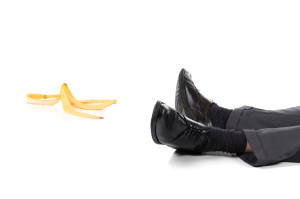
If this is a familiar scenario, and one that you have encountered on more than one occasion due to leg weakness or a neurological disorder, then investing money in equipment that will assist you to more easily get up from the floor may be worthwhile. There aren’t an extensive number of equipment solutions available for fall recovery, but there are at least a handful of good possibilities you can consider. Some of the pros and cons of these different options are discussed below.
“Step Ladder” Products for Fall Recovery
The first category of fall recovery equipment are step-based products. Both the Paraladder and the ResQup fall under this category and are designed to help you incrementally lift your bottom upwards from one step to the next in a seated position. Once you have ascended from the floor level to the top step of the equipment you can then slide backwards onto a bed, chair, or wheelchair. Step-based products are portable so they can be used anywhere inside the home, or even outside in the yard.
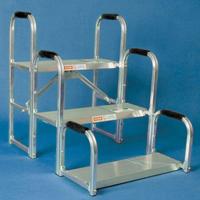 |
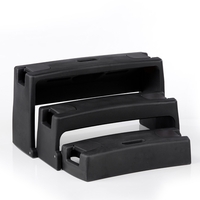 |
|
| Paraladder (Price range: $950-$1,000) | ResQup (Price range: $350-$400) | |
| Pros: |
|
|
| Cons: |
|
|
The Paraladder and ResQup differ from each other in the following respects:
- The Paraladder has raised handles on either side of the steps, which can give you extra leverage in lifting your bottom up the stairs.
- The ResQup is designed with a shorter distance between each of the steps, making it easier for you to ascend the stairs if you have reduced arm strength. It has padding on the steps and rounded step edges, which will help prevent the skin from being sheared, as well as make it more comfortable if you want to use your elbows to assist in pulling yourself up the stairs. And, if you are a user who has the ability to walk, the ResQup has an additional feature, which the Paraladder does not. The two lower steps of the ResQup can be pushed backwards underneath the uppermost seat once you have moved your bottom up to the topmost step. This allows you the ability to position your feet firmly underneath yourself and to stand up directly from the equipment itself, which is helpful when you are not near a chair or bed to transition backwards onto.
Inflatible Emergency Lifts for Fall Recovery
Both the Elk and Camel Lifts are air-inflatable devices. You simply roll, or move over onto the device when it is deflated, and at the push of a button it inflates and raises you up to a seated level.
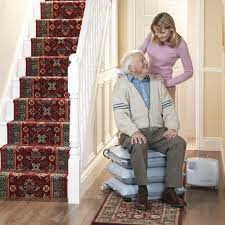 |
 |
|
| Mangar Elk Emergency Lift (Price range: $1,600-$2,500) |
Mangar Camel Emergency Lift (Price range: $2,400 – $10,900) |
|
| Pros: |
|
|
| Cons: |
|
|
The key difference between the Camel and the Elk is that the Camel has an air-inflated piece to support your back, which the Elk does not. The back support feature offered by the Camel provides increased support, making it possible for you to use this product independently. In contrast, if using the Elk you would need to have a second person present to assist you with sitting balance as it inflates.
Mechanical “Hoists” for Fall Recovery
Mobile Patient Lifts and Ceiling Lifts are mechanical hoists that can be used to assist you up from the floor. To use this type, you merely need to roll over onto a cloth sling or fasten a harness around you and then with the push of a button the machine does all the work to lift you up. The Mobile-style Patient Lifts have wheels, which allow the equipment to be rolled in to different rooms. In contrast, Ceiling Lifts can typically only be used for assistance getting down to and up from the floor in the room where they are installed.
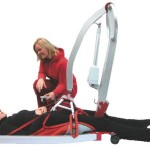 |
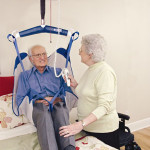 |
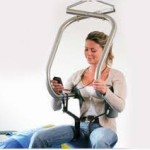 |
|
| Patient Lift (see note [a]) | Ceiling Lift (see note [b]) | Ceiling Lift (see note [c]) | |
| Pros: |
|
||
| Cons: |
|
||
| Notes:[a] Many companies offer this style of lift. Product shown is by MoLift. Also note that not all mobile lifts can be used for floor transfers so check with the manufacture prior to purchase. [b] Many companies offer this style of lift. Product shown is by Guardian. [c] Many companies offer this style of lift. Product shown is by SureHands. |
|||
Fall Recovery Equipment Amazon.com
Transfer Vest for Fall Recovery
The Smart Lift is a special vest designed for allowing a caregiver to more safely assist you in getting up from the floor. According to the product’s designer, a single caregiver may in some cases be able to assist you to stand up using the Smart Lift vest; however, having two people would be more ideal for the safety of all involved.
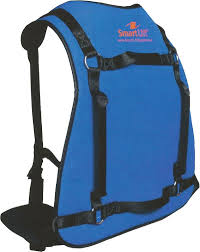 |
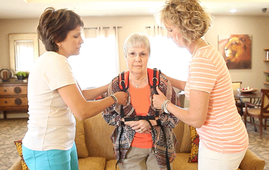 |
|
| Smart Lift ($250-$300); | Smart Lift in action | |
| Pros: |
|
|
| Cons: |
|
|
Fall Prevention Equipment Amazon.com
We recommend you always seek advice from your physician or therapist about the appropriateness of a product for your needs, prior to purchase.
Learn more about falls and fall prevention:
- Video: “How to get up from the floor after a fall – MacGyver Style!”
- “I’ve Fallen!” Tips for Rescuing Yourself After a Fall
- 12 Barriers to Independent Living – and 36 Ways to Break Them Down!
- Home Safety Tips
- Afraid to Fall?

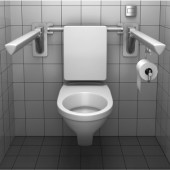
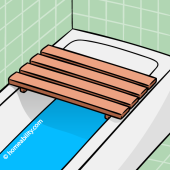
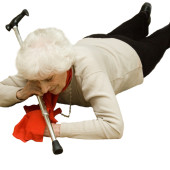
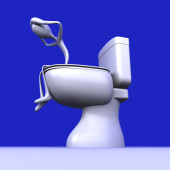
I AM A 84 YEAR OLD PRACTICING DENTIST AND I HAVE BEEN FALLING. THIS A.M. I FELL IN THE TUB WHILE TAKING A SHOWER IN A BATH TUB AND COULD NOT GET UP OR OUT. A NEIGHBOR PULLED MY HANDS AND I LEANED BACK AGAINST THE FAUCET AND GOT UP AND OUT. THIS IS A GRAVE PROBLEM AND THESE PRICE ARE RIDICULOUS FOR THE PEOPLE TO BUY.. I BELIEVE A BALLOON UNDER MY REAR COULD LIFT ME UP SO I COULD STAND. IT IS HARD TO GET ONE FOOT ON THE GROUND THAT DOES NOT SLIP AS IT DID IN THE BATHTUB. THIS IS A BIG PROBLEM AND I WOULD BE HAPPY TO WORK WITH YOU TO DEVELOP AN AFORDABLE SOLUTION.
I live ina Mobile Home Park for Seniors.. I have neighbors who fall often so am helping them all the time. I suggest canes and walkers, but they are very stubborn and do not want that it the necklace to all for help. Will show this video and hope this will work. Thank you
I am 73 and i live alone in San Francisco in a 2 story house. the house has 10 to 11 FT ceilings that need light bulbs, Fire Co2 replacement and light fixture replacements. I have a life-Long friend who was a firefighter for over 30 years. He did hundreds of rescues and he suggested a few things to prepare yourself IF you are on a ladder Don’t overreach your ladder. Get the proper size ladder that is tall enough so you can do your work and be supported in the chest.First put your cell phone on your body in a secure fashion & unlock your front door just while you’re doing this. You don’t want firefighters to split the door apart, and the make it unlockable when the ambulance takes you, Have your house keys and your wallet with you . His thoughts were to do whatever you can do to be safe and don’t let the situation get a way from you, in terms of preparations,
if the client is unattended (lives on their own) and unable to get up from the floor, are there any devices on the market that are able to help the person get up by themselves?
The most appropriate device will depend on each user’s unique set of strengths and weaknesses. The step ladder type options shown in the article above can be used independently by some individuals, if they have enough upper body strength to lift themselves up the steps. The Manger Camel Emergency lift with the backrest can be used independently by some individuals, if it were inflated and used near to a wall, grab bar, or sturdy piece of furniture which they could use for additional support when standing up. Ceiling lifts with a dangling sling (equipment that is installed on the ceiling or a portable track) can be used independently by some individuals. Note: Not all ceiling lifts are designed to be used independently. Some require the assist of a caregiver to propel a person along the track. If this solution is selected, the person would need to choose a power traversing ceiling lift track system that allows the user to independently self-propel themselves over the tracks.
The next problem that presents itself though, is how to get to the equipment independently, if a person falls out of reach of the equipment. Some persons will roll to get to the location where the equipment resides, others may use techniques like the two shown at the end of the video that’s attached to this article: How to Get up From the Floor MacGyver Style.
Persons who are unsure they’d be able to rescue themselves, even with equipment, should implement additional safety measures, some of which are outlined in this article: “I’ve Fallen!” Ways to Rescue Yourself”
PS. to my post:
Chronic progressive neuro behcet’s, is a rare form of vasculitis.
In some ways, it is a lot like MS, but much worse in many ways.
I live alone, so knowing how to get up by myself, is very important!
Thank you, again,
Cindy
Thank you for your videos of “how to get up from a fall”.
I am 66 years old, I have chronic progressive neuro behcet’s.
I broke 4 PELVIC BONES in a ground level fall 3 years ago. One did not heal right.
Now, I have started falling and even passing out
My doctor has not been able to figure out WHY, or how to treat it. The doctor did not address – HOW TO GET UP FROM A FALL.
AFTER I fall, (without hitting my head), I am “befuddled” for a number of minutes before I try to get up . I just lay there, my brain /body has to focus on how to get up.
Not to long ago, I just bounced right back up, without thinking about it.
I hope repeatedly watching your YouTube video a number of times, will stick in my memory, to help me get up.
Thank you for addressing what many take for granted and don’t understand. Thank you making a vital, useful video!
Cindy
I have MS and now cannot get upl on my own. My wife is just not strong enough..
The inflatable option above is just to expensive. I have started experimenting with a car tyre inner tube and and a handheld battery car tyre inflator.
My first attempt did not work but I think this idea has merit and I will persevere. Anyone else tried this? Or anything else?
Mike
Thanks for this article. My husband is falling more and though I’m pretty strong, his ability to assist is diminishing. You’ve presented some options with pros and cons quite clearly!
My mum has MS so has limited mobility when she has a fall which makes it tricky to get her up again
After seeing the paramedics use the ELK we considered buying one but they were far too expensive
What we’ve used instead (which works very well) is a self inflating air bed mattress – one which comes quite high off the ground. This is enough to get mum off the ground and comfortable until she’s ready to be transferred into a chair, or has a comfy place for a rest in the meantime!
Would really recommend
Hope that helps someone xx
I’ve often wondered how well an air mattress would work for this scenario and whether the air pump for an air mattress would be strong enough to lift someone while they were on top. I’m happy to finally learn the answer. Thanks for taking the time to share your experience and suggestion with others!
Great idea & not too expensive! I’m going to buy a self inflating air mattress tomorrow. My mom fell this week & it took me 2 1/2 hours to get her up using a ramp she could inch her way up and into a chair. I don’t want to go through that again!
I have seizures sometimes, which cause me to fall. My daughter has always been there to help me up, but she just began college this year & the rest of my kids live in other states so I’m alone in the house now. I have a lifeline, which I used when I fell last week, but I hate to call emergency every time I fall. The whole time I was waiting on the floor I kept thinking Ugh! I have become the lady from the commercial “I have fallen and I can’t get up” and figured there has to be another way than lying around waiting to have the emergency guys break down my door. I really like the idea of the inflatable lift, but that just isn’t in my budget. I am going to give the Resqup thing a try first and see how that goes, but I am not certain I will have enough arm strength to pull myself up the stairs…fingers crossed.
Hi Sarah,
If you haven’t already, you might consider giving a trustworthy neighbor a spare key so that the emergency team doesn’t have to break down the door if you need help again in the future.
Also, the holidays are almost upon us, so if you and your children have a tradition of exchanging gifts perhaps you can suggest that they put their money together with yours to help you buy one of the inflatable lifts – if you feel that will better meet your needs.
Another suggestion. Put a lock key box out in front of your home. Give the fire department the code to get in the box for a key to open your door. Have one by our garage door in case I am gone for my Mom to get the fire department to help.